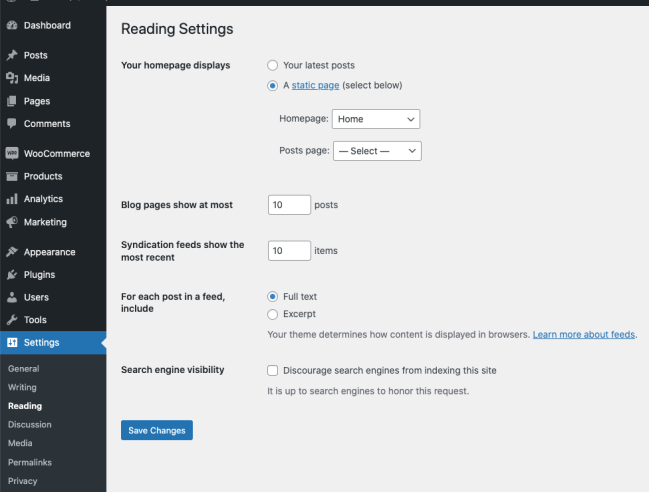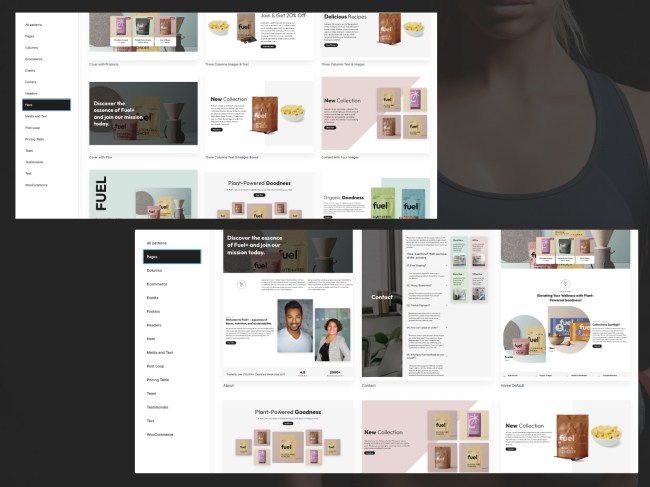Installation and Setup
↑ Voltar Para o Topo- Go to your WooCommerce.com account Downloads page. Click the download icon to get a compressed fuel.zip file on your computer.
- On your website, go to Appearance > Themes and click the Add New button.
- Click Upload to upload the fuel.zip file you downloaded in step 1.
- Go to Appearance > Themes to Activate.
How to start working with the theme?
↑ Voltar Para o TopoImportant: to be able to effectively use this theme, with all its features, it is required to have the latest WordPress version installed and the default block editor enabled.
There are two ways to start building your site with this WordPress theme.
1. Replicating the demo website and then starting from there.
This method is very practical if you have a fresh new website, a clean WordPress install or you’re new to WordPress.
Navigate to Appearance > Demo Content or click on the Get Started button, and there you’ll find demo to import.
2. Starting from scratch with your own content
This method might be more practical in case you already have a live website with lots of content and you’re simply switching from a previous theme. Also if you’re already experienced with WordPress and want to build your website page by page. With this method, you won’t be importing demo pages and posts.
Check the “Pages” section of the documentation for guidance on how to create page layouts using block and page patterns.
The Next Steps
↑ Voltar Para o TopoThere are, of course, many different ways one can approach building a website. However, the most common is to start with the Homepage. There are 2 types of Homepages in WordPress: static and dynamic.
The static homepage displays the content you added to one specific page while the dynamic automatically lists all your blog posts chronologically.
Static Homepage: the demo website of the “Fuel” theme features a static homepage.
To start creating your front page navigate to the Pages, create a new page and name it (in the demo we named it “Home”).
By default, on the Homepage, WordPress displays your latest posts. If you want to set the page you created as your homepage just navigate to Settings>Reading and instead of the default “Your Homepage Displays: – Your latest posts” select “A static page” and from the drop-down choose the page you created.

Pages
↑ Voltar Para o TopoLayout Patterns Intro
↑ Voltar Para o TopoMaking things simple is what we love to do. All the elements you see in the theme demos are included as block & page patterns within the block editor. With a simple drag and drop, you can arrange them in any way you want and adjust them to perfectly fit your project.

All available block and page patterns are sorted in different categories: Header, Footer, Hero, Columns, Events, Pricing, Media and Text, Text, Testimonials, eCommerce, Pages .
You can also easily mix patterns from different categories. No restrictions there.
Once you have added a block pattern to your page, you can start replacing its sample text and images with your own. Every block pattern is very flexible. You can style, delete or duplicate sections of every pattern to suit your needs.
Creating Home Page
↑ Voltar Para o TopoNavigate to “Pages > Add New” and add the title of the page, in this case let’s name it “Home”. Click on the Toogle Block Inserter (blue “+” sign) and click the “Patterns > Explore”. Here you’ll find all available page and block patterns you can use for creating pages.
In the example below we recreate the home page by inserting the whole page block:
Of course, you can create your home page by adding and customizing various block patterns as demonstrated below:
The same way you can create any other page, by adding complete page blocks or adding block patterns one by one. I’d recommend creating a couple pages and adding some content first before setting up the Header/Menu and Footer part.
Header & Menu
↑ Voltar Para o TopoTo set up your header part & menu, please navigate to Edit Site.
Selecting a header layout
↑ Voltar Para o TopoFuel comes with a few pre-set header layouts you can choose from. Headers are created with blocks which means you can easily rearrange them, add more blocks, remove blocks you don’t need, change colors etc., as shown in the example below.
Footer
↑ Voltar Para o TopoTo set up your footer, please navigate to Edit Site.
Select a footer layout
↑ Voltar Para o TopoFuel comes with a few pre-set footer layouts that you can choose from. For easier understanding of how to switch between footer layouts check the video below.
Blog
↑ Voltar Para o TopoThe first step in creating your blog page is to create a couple of posts.
Creating a post
↑ Voltar Para o TopoTo create your first post navigate to “Posts” and click the “Add New”.
Now in the post editor you can add a title, content and create layouts using blocks just like you would on a page. You can upload the featured image from the “Featured Image” section in the right sidebar of the editor.
You can now categorize your posts using the “Category” feature and, if you want, choose to disable comments for that particular post.
Read more about writing a posts here: https://wordpress.org/support/article/writing-posts/, https://wordpress.org/documentation/article/query-loop-block/
Create a Blog Page and choose the layout
↑ Voltar Para o TopoNavigate to “Pages > Add New” and add the title of the page, in this case let’s name it “Blog”. Click on the Toogle Block Inserter (blue “+” sign) and then click “Patterns > Post Loop”. Here you’ll find a selection of blog layout patterns. Select the one you want to use for your Blog Page.
Once you selected the layout click “Publish” and the posts you created will automatically be displayed on this page.
Shop
↑ Voltar Para o TopoFor more information about WooCommerce options, setting up payment gateways and more please check the plugin documentation.
Settings and Options
Navigate to the https://woocommerce.com/documentation/plugins/woocommerce/getting-started/settings/ for more info.
Set up Products
Go to “Products > Add New” to add your first product. Enter the name of your product and then a detailed description.
Navigate to the https://woocommerce.com/documentation/plugins/woocommerce/getting-started/setup-products/ for more info.
Sell Products
Navigate to the https://woocommerce.com/documentation/plugins/woocommerce/getting-started/sell-products/ for more info.
Create a default Shop Page
This page will automatically display all your products using a predefined layout. To set it up you need to create a page and then assign it to be the shop page in “WooCommerce > Settings > Products“.
The URL of this page will be set automatically as www.yoursite.com/shop
Create a Shop page using WooCommerce Blocks
You can also easily create a shop page using dedicated WooCommerce blocks.
Navigate to “Pages > Add New” and add the title of the page, in this case let’s name it “Shop”. Click on the Toogle Block Inserter (blue “+” sign) and click the “Patterns > Pages”. Here you’ll find all available page patterns you can use for creating shop pages.
Styles and Fonts
↑ Voltar Para o TopoStyle Variations
↑ Voltar Para o TopoThe introduction of block themes has brought with it a new feature called style variations in WordPress 6.0. This is just a glimpse of the exciting new era of WordPress theming, known as Full Site Editing. Style variations are different pre-designed styles that you can easily apply to your site, all within the same theme. With this feature, you can quickly change the look and feel of your website with ease.
Fonts
↑ Voltar Para o TopoThe Fuel theme features the elegant Outfit font, as showcased in the demo. However, if you desire to personalize your website with a different font, Fuel offers a wide range of 9 font options for you to choose from through the new Site Editor.
Classes that can be used:
↑ Voltar Para o Topo- image-animation-from-top – images with this class will animate when they enter the viewport. Animation is reveal, from the top.
- image-animation-from-left – images with this class will animate when they enter the viewport. Animation is reveal, from the left.
- image-animation-from-right – images with this class will animate when they enter the viewport. Animation is reveal, from the right.
- animate-from-top – element with this class will animate from the top, when it comes into the viewport.
- animate-from-bottom – element with this class will animate from the bottom, when it comes into the viewport.
- animate-from-left – element with this class will animate from the left, when it comes into the viewport.
- animate-from-right – element with this class will animate from the right, when it comes into the viewport.
